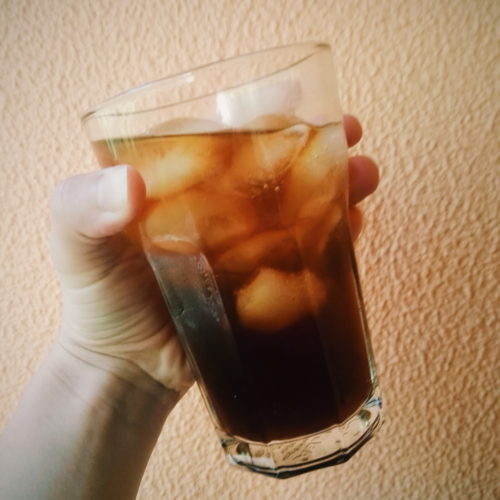Imagine: You're a specialty coffee lover and you buy a 250g bag for 10 euros.
How would you make this coffee? Would you use 40 grams, wait 24 hours, and have enough concentrate to make 2-3 cups, or could you make a V60 from 15 grams of coffee? Which will give you 220 grams of highly caffeinated liquid in the next 4 minutes? :)
Has it ever happened to you? You're tasting a coffee, and immediately thinking, "It tastes good, but that would be just as amazing as a cold brew! I have to make a cold brew!»
Has this ever happened to you? No? Me neither.
And if you think about it, it's a little strange.
Sometimes you drink a coffee like an espresso, and then you get curious and want to savor it through the filter. Or you drink a coffee and immediately think about how you're going to make it. V60? Aeropress? Espresso? You're asking yourself those endless, yet so dear to the heart of every coffee lover, questions: "What do I want to enhance? The smoothness of the body? Notes of red fruits? The delicacy? How do I make this coffee reach its full potential?"
But it never happens that in that line of coffee brewing methods to choose from, you have a cold brew.
And if cold brew is just a method of making coffee, that's pretty unfair.
But… what if it’s something more?
Let's dive into the topic for a moment.
When I say “cold brew” in this post, I’m referring to immersion cold brew, which is by far the most popular method of cold brewing.
There is also Kyoto-style cold brew, where the coffee is brewed in a special glass "tower" and water slowly drips through the coffee, literally drop by drop.
Kyoto-style cold brew, like probably most Japanese devices, is more of an art than anything else, and the visual aspect is simply spectacular!
It's also a fairly expensive device, which at the same time doesn't produce much liquid, so it's not often used for producing cold brew in large quantities. However, for those who love making coffee at home, there are options that cost around 25 euros, making Kyoto-style cold brew a fairly affordable option.
The most popular cold brew preparation method is immersion. It involves mixing medium-coarse ground coffee with cold or room-temperature water, then letting it sit at room temperature. As with any recipe, you're free to experiment with brewing times, grind size, and ratio. The most popular ratios are 6:1 or 7:1 water:coffee.
After 18-24 hours of steeping, filter the coffee concentrate and store it. Then you're free to do anything with it, depending on how much you want to dilute it.
Cold brew coffee concentrate gives you a great deal of freedom in blending and making the final beverage, which can be literally anything: cold brew, hot brew, iced coffee, latte, coffee-based cocktails, etc.
From this point of view, cold brew coffee is extremely versatile.
So let's go back to where we started.
Why isn't cold brew in line with all the others, like espresso, V60, Chemex, etc.?
The main question is this: Is cold brew a standalone coffee brewing method, or is it simply a tool?
I won't jump to any crazy conclusions here, but I'll walk you through the strengths and weaknesses of cold brew.
+ CB is extremely versatile and can be a base for many coffee drinks and cocktails
– CB does not have as intense a “coffee flavor” as espresso, therefore it has a tendency to get “lost” in cocktails
+ Speaking of cold brews, working with CB is easier than with iced filter coffee, because you don't need to calculate the ice melting, and because the concentrate you use is already cold.
– Although you don’t have to calculate ice melting when making cold brew, it would be best to use the refractometer at least when creating the recipe, to achieve a desirable TDS, and to know how the concentrate you are creating behaves with ice and milk when served.
+ the cold preparation can be prepared in advance, stored in the refrigerator, and easily served throughout the week
– Making a batch of cold brew takes 18 to 24 hours. Compared to the usual 2-4 minutes to make a filter and experiment with grind size, 24 hours seems like a long time to wait only to discover you've done something wrong. And if you're out of cold brew, you're really out. It will really take a while to make more.
+ It generally has a smooth, easy-drinking profile without pronounced acidity or bitterness, making it an easy sell to people who don't like coffee with a strong personality, and prefer something more delicate.
– One drawback of cold brew being bland is exactly what some people consider a positive side of cold brew: the drink lacks character, compared to the same coffee prepared another way.
– High ratios. You have to use a lot of coffee, and not very efficiently. So, if you don't own a roaster or have free coffee, making cold brew ends up being quite expensive.
+ The positive side of this is that roasters often use cold brew to “move” the coffee and give it a second life.
– Under control of the extraction. Basically, you choose the recipe, grind size, and steeping length, and wait to see what happens. You can't control much, especially if the location where you're steeping is subject to temperature and humidity fluctuations.
To put it all together, cold brew is the best thing to do if you want to use up some extra coffee you already have that's getting old. It's a good way to prepare coffee "in advance" and store it, or even freeze it, and ultimately save some time on brewing. It's a great thing to do if you like smooth, delicate coffee.
And summer. Summer is the perfect time for cold brew :)


